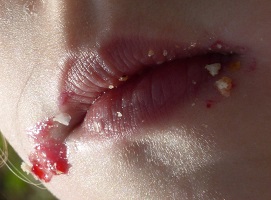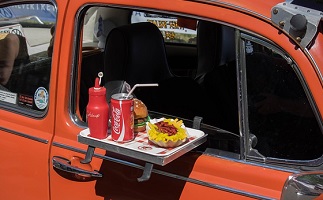If you're struggling with bulimia, I have some really bad news; it is one ferocious, nasty habit. I also have some great news; habits can be broken. After a 20-year battle with my own wicked bulimic cycle, I can thankfully now say: the eating disorder cycle can be broken. Often, the unraveling can start right where the first patterns were braided in. For me, that was my date with the drive-thru.
The Voice of Bulimia Becomes Vocal About Recovery
I’ll admit, I'm no scientist. I don’t have a lot of fancy letters behind my name. But I am an eating disorder survivor, and a vocal one, writing about my recovery from bulimia on my blog and in my book, What Goes Down.
In the past, I fell prey to a convincing voice in my head telling me to binge and purge. I have learned—from reading accounts of other survivors—that many others suffer from the “voice of bulimia” too. What shocked me is not how different we all are, but how similar. But I am living proof that bulimics can beat their eating disorder. If I can do it, you can too, when you understand how bulimia tricks you. So, let's get into that...
How a Diet Can Kick Off an Eating Disorder
For many, an eating disorder begins with a benign decision to diet. You want to feel better by becoming slimmer, so you restrict a few “bad foods” from your diet. Frankly, in today’s culture, it seems if you’re not dieting you’re a lazy outcast who has no idea what it takes to “look good” under today’s accepted skinny norms.
But, here's the problem when you start to restrict. Your brain starts to think you’re starving to death. Animal instincts buried deep in your subconscious kick in and your body begins storing fats, quelling hunger cues, and growing a deeply-rooted obsession with food in the hopes of motivating you to do the one most important thing your body needs you to do right now: FEED IT.
Initially, it's possible to ignore this plea from your brain. The pounds are dropping off and you feel victorious. But your brain is programmed for survival. Eventually, it will (mark my words, it will) always win out.
How the Bulimic Cycle Begins
Since you’ve been restricting, the minute your brain forces you to eat, you will likely go on a mad, reckless binge. Your body needs you to, because it perceives a famine.
What happens to you then if you have an eating disorder? You flip completely out. You just ate a ton of bad food! That’s totally not allowed. Hence, the first binge-and-purge cycle seed will be planted.
"If I do that again", you tell yourself (which, from what I’ve just disclosed about the brain and its superior control, you unfortunately will), "I now have an out!" That is how it starts for many. Once you begin to binge and purge with regularity and (sadly) growing ease, this pattern can progress from a subconscious need into a pleasurable habit. For me, this was my date with the drive-thru.
How Binging Becomes a Habit
I don’t like to admit this, but I used to stuff my face while driving around in my car hitting up three of my favorite drive-thrus. I’m sure the drive-thru clerks saw right through me and my tortilla-caked teeth. I don’t know who I was trying to fool—me or them—because I honed this daily habit. I looked forward to it. I daydreamed about it.
Each day, as I nibbled on my fat-free, taste-free bran-whatever for breakfast and my less-than-100-calorie salad for lunch, I knew I was building up my taste buds for that deliciously-satisfying fall. Unfortunately, this is how many bulimia sufferers grow the habit. But, as I mentioned, I do have some great news. Since it is merely a habit—not an actual need—it can be broken.
How to Break the Bulimia Habit
A habit’s weakness is its predictability. You know when you’re likely going to want to do it most; in what conditions or circumstances. This means you can start to chip away at it by shaking things up.
If you eat five croissants with coffee on your terrace every morning, you'll have a huge urge to repeat this behavior, because it's stored in your brain as a habit. Ditching the coffee for tea, or swapping your terrace for a local coffee shop could help you stop your croissant habit. Eliminating one condition at a time helps you take a few mental strides away from your habit.
How I Broke Up With the Drive-Thru
With my drive-thru date example, I liked to do this every afternoon, right around the end of the workday, after 12 hours of restricting or fasting. After years of this lonely, expensive, disgusting pattern, I finally hit rock bottom and had to make a change.
I began by trying to change my daily pattern. Eating a bigger breakfast or lunch was hard, but other conditions were easier to change. I drove home via roads free of drive-thrus. I left my car at work and walked home. I left my credit cards and cash in my office drawer, so I couldn't buy food on the way home. I forced myself to make and keep dinner dates with others.
These things may sound silly, but if you're suffering from an eating disorder, you must start where you can. Break the tiniest bit of your formula for binging to start putting chinks in bulimia’s armor. Small changes lead to big results, I promise. Keep changing. Keep chipping. And, the urge to continue your bulimic cycle will slowly start to fade.
About Callie Bowld: After healing from bulimia, Callie became inspired to help others. Her book What Goes Down: The End of an Eating Disorder can help bulimia sufferers "kick the shit out of their disease", in Callie's words. You can find Callie's feisty posts on her blog about bulimia and body image or follow her on Instagram.






